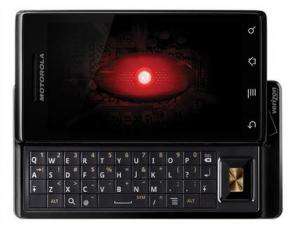New handbook for Google, Droid users

Before buying one of the new Google-powered "Droid" phones from Verizon Wireless, you may want to read the manual. Not the setup directions in the box.
No, the essential guide for Droid owners -- and anyone else moving their life onto Google technology platforms -- is a 384-pager written by The New Yorker media writer Ken Auletta.
"Googled: The End of the World as We Know It" is a definitive, semiauthorized history of the enigmatic company and analysis of its coming challenges.
It's drawn from amazing access Auletta had to the company's founders, investors and employees, with perspective from media and tech titans thrown off course by the search supernova.
The book is also a candid look at tensions within the Googleplex -- between its idealism and commercial ambitions, iconoclastic founders and maturing company management challenges -- and its overarching drive to play an ever bigger role in people's lives.
Most striking of all, for people familiar with Microsoft's history, is how much Google resembles its nemesis in Redmond, Wash.
Both have quirky and confrontational founders, dogged by accusations they poached breakout products, so fervent that they miss growing concerns about their fantastic success.
The book was apparently finished before Verizon and Google were ready to disclose their work on the Droid with Motorola. "Googled" went on sale last week, three days before the phone's debut.
Verizon Communications Chief Executive Ivan Seidenberg told Auletta the company was watching Google develop Android but had concerns about being "out-positioned" or "captive."
"Google's vision of Android is Microsoft's vision of owning the operating system in every PC," Seidenberg said in the book.
Imagine what would happen if Microsoft gave away a new version of its operating system, to extend its monopoly to a new platform.
Today's hot platform is the smartphone -- a pocket computer with calling features or vice versa.
Software running the core of these devices isn't the battleground as much as are the layers of services on top.
These layers connect the devices to search engines that pull information about how and where the devices are being used and by whom.
This data stream improves search results and enables search companies to deliver more timely and precise ads for its clients. When you search for pizza on the Droid, its GPS helps the map show the nearest parlor.
On the Droid and other Android phones, it's like an external operating system, binding the hardware to Google's processor and memory in the ether.
You don't have much choice. During the initial setup, you're prompted to set up a Google account or connect to one you already have, linking the device to Google's omnivorous supercomputers.
In return, you get a phone that's automatically synced with Google's maps, e-mail and navigation systems.
Last week Google made a gesture to ease the implicit privacy concerns, releasing a new "Dashboard" that shows how you've been using its services.
But it seems to be having the opposite effect. People are shocked to see how many of their online footprints Google remembers.
Reading Auletta's book and testing the Droid over the past few weeks, I realized how much of Google's contradictory character is embodied in the $200 device.
The Droid is heavier than it looks, with a solid, angular case that's been described as Darth Vader's phone. The Google force is strong with this one.
Standout features -- besides a crisp touch screen, slide-out keypad and 5 megapixel camera -- include its browser, maps, voice-controlled search and a turn-by-turn navigation feature that displays and "speaks" driving directions. The phone is the first to use version 2.0 of the Android system that debuted a year ago with T-Mobile USA's G1.
The Droid's voice-recognition and navigation features work well, but the multiple steps to use them take a little getting used to. Some users may think they're wonderful, but the features seemed to me as if they were strutting technical prowess as much as advancing the phone's utility. Too bad not as much effort was put into the camera, which was slow to shoot, making it tricky to get a crisp shot.
True to Google's environmental ethos, the Droid also provides bus and walking directions. But one time the Droid told me to walk several blocks and transfer to catch a bus that I could see was approaching my stop (if I looked up from the phone).
The Droid's case seems more solid and durable than the first Android phones released by T-Mobile, but I prefer their smoother edges in the hand. The Droid also has an annoyingly small power button that you have to press frequently to wake the device, and the battery cover slipped off a few times when I held the phone too tight or jostled it in my pocket.
According to "Googled," a seminal influence on co-founder Larry Page was Donald Norman's book "The Design of Everyday Things," which contends products aren't usually designed from the perspective of consumers and are too confusing to use. This is "the paradox of technology: added functionality generally comes along at the price of added complexity."
That idea guided the design of Google's search engine -- not only its minimalist aesthetic but the efficient, useful and natural function of its systems.
But it must be hard to maintain this approach when building increasingly powerful software for a range of devices made and sold by other companies.
Perhaps this will be another area where Google shares Microsoft's experience. Android 1.0 was exciting and 2.0 has cool new features, but people who don't need a bleeding-edge phone may want to wait for version 3.0.
___
(c) 2009, The Seattle Times.
Visit The Seattle Times Extra on the World Wide Web at www.seattletimes.com/
Distributed by McClatchy-Tribune Information Services.





















